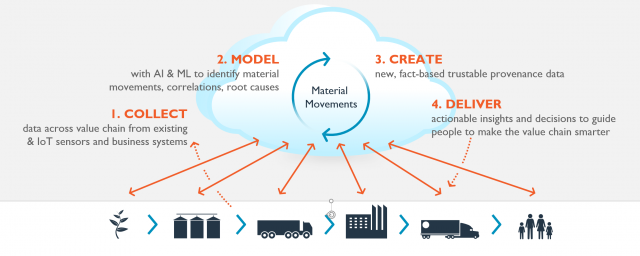In this section you will learn about the high-level architecture of the platform. It is useful to understand how your instance of ThinkIQ is deployed and how it connects to the many parts of your supply chain. At the conceptual level you will have one instance of ThinkIQ running in the cloud with data flowing into and back from the platform from many parts of your supply chain. In the picture below we show a typical Food & Beverage supply chain that starts at the Farm and ends with the Consumer. This is often referred to as "Farm to Fork".

The platform is shown in the cloud with data flowing into it from the Farm (typically directly from smart farming equipment), from the Grain Elevators or Storage Bins that store the agricultural product (typically from climate control systems and simple sensors measuring levels), from vehicles that transport the product to and from the storage locations (often from camera systems, sometimes from smart trucks) to the factories (this data usually comes from the industrial automation systems) to Warehousing (robotics systems or WMS systems) through logistics (data retrieved from the 3PLs) and Retail and finally from the consumers' interaction with the final product. Alongside the real-time data from each part of the supply chain is the business data relating to material receipts and shipments (typically from the ERP layer) and lots of quality data (usually fragmented in many systems).
At most points in the supply chain the way the data flows is simple and similar; Gateways are installed on-premise with one or more Connectors that know how to talk directly to the many systems described above. Learn more about connectors here. There are some exceptions to this pattern when you will not use Gateways and Connectors:
- Smart Devices. These devices can communicate over rich standardized protocols. They can connect directly to ThinkIQ without needing help. Smart Devices can do the following:
- Register - a complex term for "Hello, my name is John"
- Exchange Information Models - "I am a Human Male, with a date of birth, social security number, marital status and insurance details"
- Live Data Exchange -
- "10:15 am: My temperature is 102.5 degF, pulse 101 bpm and coughing"
- "10:30 am: My temperature is 103.2 degF, pulse 115 bpm and coughing a lot"
- "11:15 am: My temperature is 104.5 degF, pulse 123 bpm and struggling to breathe"
- Commands - "Go to a doctor now"
- IoT Aggregators. All of the major tech vendors (Microsoft, Amazon, Google) have IoT platforms that can make a lot of things look like smart devices. Your data can flow to one of these platforms and then to ThinkIQ. A good example of this is Smart Trucks as demonstrated in the tutorials for Microsoft Azure IoT Central.
- Software Applications that will dynamically read and write potentially complex data structures to and from ThinkIQ will usually use our GraphQL interfaces. Learn more about GraphQL here.
- Applications that wish to periodically export data to ThinkIQ can write files to the built-in Secure FTP server. The File Importer will detect new files and automatically import the data into ThinkIQ. The importer has many powerful features and is fully extensible.
